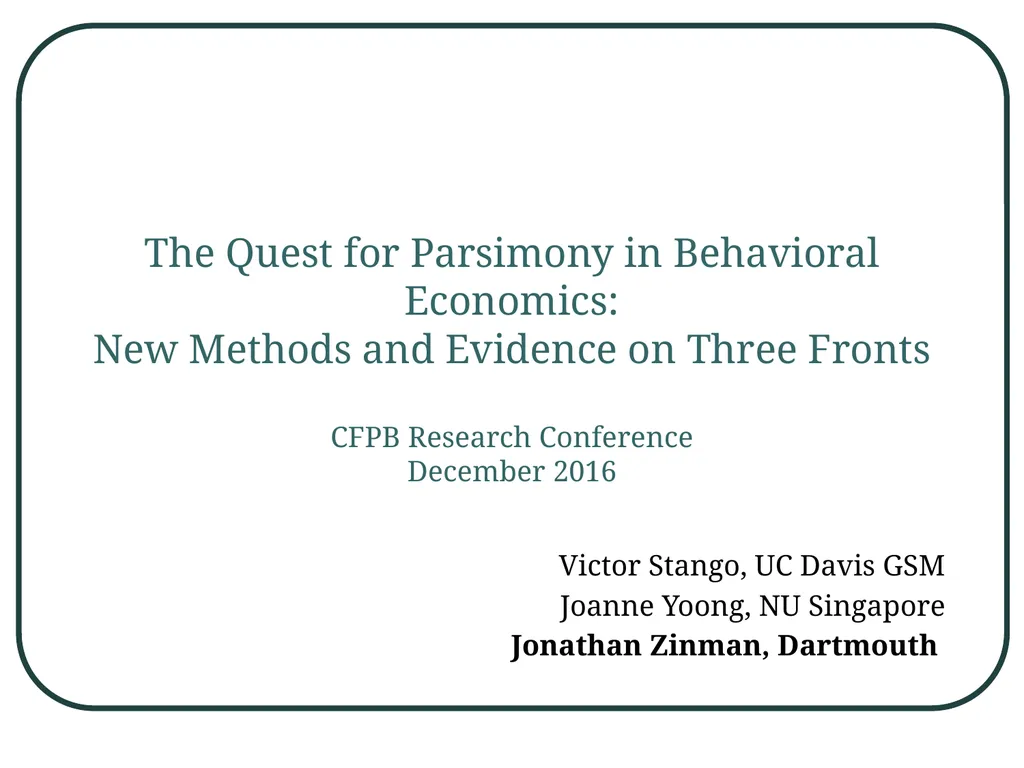The Quest for Parsimony in Behavioral Economics:
Author : mitsue-stanley | Published Date : 2025-06-27
Description: The Quest for Parsimony in Behavioral Economics New Methods and Evidence on Three Fronts CFPB Research Conference December 2016 Victor Stango UC Davis GSM Joanne Yoong NU Singapore Jonathan Zinman Dartmouth Behavioral Economics its
Presentation Embed Code
Download Presentation
Download
Presentation The PPT/PDF document
"The Quest for Parsimony in Behavioral Economics:" is the property of its rightful owner.
Permission is granted to download and print the materials on this website for personal, non-commercial use only,
and to display it on your personal computer provided you do not modify the materials and that you retain all
copyright notices contained in the materials. By downloading content from our website, you accept the terms of
this agreement.
Transcript:The Quest for Parsimony in Behavioral Economics::
The Quest for Parsimony in Behavioral Economics: New Methods and Evidence on Three Fronts CFPB Research Conference December 2016 Victor Stango, UC Davis GSM Joanne Yoong, NU Singapore Jonathan Zinman, Dartmouth Behavioral Economics & its Successes We now know that insights from psychology can improve on classical economic models of decision-making Preferences: present-bias, loss aversion, preferences over certainty/ambiguity, choice (in)consistency Beliefs: overconfidence, gambler’s fallacies, non-belief in law of large numbers Problem-solving limitations: exponential growth bias, narrow-bracketing, limited attention/memory Big, growing impact on practice and policy 12/14/2016 Stango et al., Proliferation to Parsimony Behavioral Economics and its Proliferation Problems Mismatch between what’s known and what’s needed, for optimal treatment design and welfare analysis Proliferation problem. Manifold potentially behavioral factors (“B-factors”) Often observationally equivalent effects on choices/outcomes But with different welfare implications Little sense of which are most prevalent and/or important Little sense of how they fit together at the level of the individual Little sense of whether/how they collectively impact– or even correlate with– choices/outcomes in financial and other domains 12/14/2016 Stango et al., Proliferation to Parsimony Behavioral Economics and its Proliferation Problems We’ve been here before in research on consumer decision making, decades ago Cognitive skills (intelligences -> intelligence) Non-cognitive skills (personality psychology) (How) can we achieve parsimony in behavioral economics? 12/14/2016 Stango et al., Proliferation to Parsimony Quest for Parsimony: 3 Approaches “Survey parsimony” Can one usefully elicit a rich suite of behavioral factors (“B-factors) from a large representative sample at low(-er) cost? “Summary Statistic Parsimony”: “B-stats” Across B-factors, within-person… Is a summary/cumulative measure of “being behavioral” empirically relevant for outcomes (e.g., financial condition)? Do different B-factors have reinforce or counteract each other? “Common factor parsimony” Are B-factors tied to each other (correlated), within-person? If so, do they derive from an underlying and lower-dimensional “behavioral common factor” that links B-factors and outcomes? 12/14/2016 Stango et al., Proliferation to Parsimony Planning the Quest: Our Research Design Step 1: adapt/abbreviate recent and high-profile direct elicitation techniques for each of a broad “suite” of behavioral factors. Present-biased discounting, deviations from GARP, loss aversion, gambler’s fallacy, limited attention, exponential growth bias, etc. 17 in all Step 2: administer in nationally representative survey panel Step 3: combine B-factor data with rich data on controls, outcomes Demographics, numeracy, attention, risk aversion, patience, cognitive ability, survey effort => financial condition Step 4: use data to implement tests/explorations of the three approaches to parsimony Survey parsimony Summary














